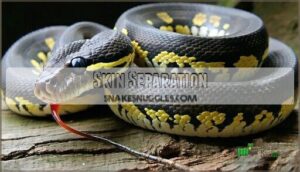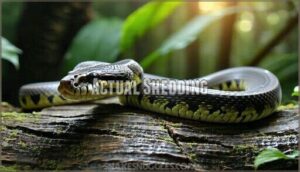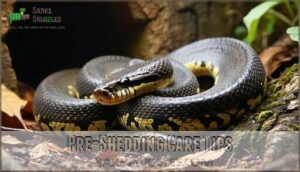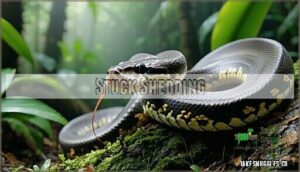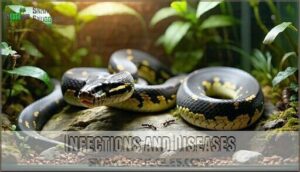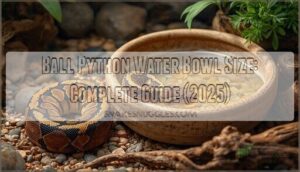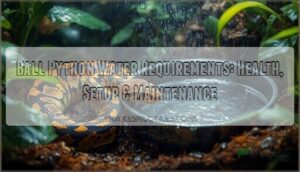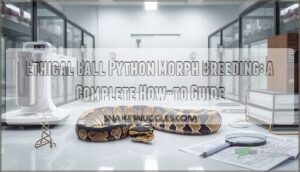This site is supported by our readers. We may earn a commission, at no cost to you, if you purchase through links.
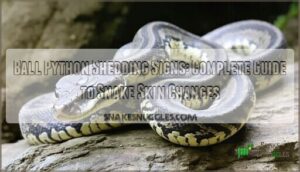
Your snake’s eyes turn milky blue, skin becomes dull and grayish, and appetite decreases.
This "opaque" phase lasts 4-7 days before eyes clear again.
During shedding, your python rubs against rough surfaces, starting from the head and working backward like peeling off a sock.
The entire process takes 1-2 weeks from initial signs to completion.
Humidity levels between 60-80% help guarantee clean sheds, while handling should be minimized during this vulnerable time.
Your snake might seem moody or hide more than usual – perfectly normal behavior that signals their body’s preparing for this natural renewal process.
Table Of Contents
- Key Takeaways
- Shedding Process Overview
- Snake Shedding Stages
- Pre-Shedding Care Tips
- Shedding Complications
- Post-Shedding Care Routine
- Frequently Asked Questions (FAQs)
- How do ball pythons act when they shed?
- How do snakes act before they shed?
- What does a ball python look like before they shed?
- What are the stages of snake shedding?
- How often do healthy ball pythons shed?
- Can shedding frequency indicate underlying health problems?
- What age do ball pythons start shedding?
- Do male and female shedding patterns differ?
- Should I remove shed skin from habitat?
- Conclusion
Key Takeaways
- You’ll spot shedding when your ball python’s eyes turn milky blue, skin becomes dull and grayish, and they refuse food – this pre-shed phase typically lasts 4-7 days before their eyes clear again
- Maintain 60-80% humidity during shedding to prevent complications like stuck shed pieces, and minimize handling since your snake’s vision is impaired and they’re more stressed than usual
- The entire shedding process takes 1-2 weeks from initial signs to completion, with your python rubbing against rough surfaces to peel off the old skin like removing a sock
- Remove shed skin immediately after completion and monitor for any stuck pieces around the tail or eyes, as 85% of shedding problems stem from inadequate humidity levels
Shedding Process Overview
You’ll notice several clear signs when your ball python prepares to shed its skin, including cloudy eyes, dull coloration, and increased hiding behavior.
Understanding these indicators helps you provide proper care during this natural process that occurs every 4-8 weeks in healthy snakes, which is a key aspect of proper care.
Ball Python Shedding Signs
You’ll typically notice several ball python shedding signs before the actual process begins.
Watch for dull, faded skin that loses its vibrant patterns, especially along the sides and belly.
Your python’s eyes will turn cloudy or blue-gray, signaling impaired vision, and a pinkish belly tint often appears first, followed by increased restlessness and appetite loss.
Monitoring shedding health issues is essential for maintaining your ball python’s overall well-being and addressing potential shedding health issues.
Pre-Shedding Behavior
You’ll notice your ball python becoming increasingly restless as preshedding behavior kicks in.
During this phase, your snake may refuse food completely and spend more time hiding than usual.
Key preshedding behavior changes include:
- Reduced activity levels – Your python will move less frequently and prefer staying in one spot
- Food refusal – Most ball pythons stop eating 1-2 weeks before shedding begins
- Increased hiding – Your snake seeks out dark, secure spaces more often than normal.
These snake behavior patterns signal the python shedding process is starting, making pre shed care essential for a successful molt.
Understanding the snake shedding process is vital for providing superior care during this critical phase.
Environmental Factors
Environmental factors create the perfect storm for successful shedding cycles.
You’ll need precise temperature control between 78-88°F and humidity levels around 60-70% during this critical period.
Proper lighting conditions, clean air quality, and accessible water sources directly impact your ball python’s reptile shedding cycle.
These environmental factors determine whether your snake sheds smoothly or encounters complications, making precise temperature control and proper lighting conditions crucial for a healthy shedding process.
Snake Shedding Stages
Ball python shedding follows three distinct stages that you’ll recognize once you know what to look for.
Understanding each phase helps you provide proper care and avoid complications during this natural process.
Soaking and Relaxation
During the soaking and relaxation phase, your ball python enters water therapy mode, seeking humid hiding spots to ease shedding discomfort.
This natural stress relief behavior involves extended soaking methods in water bowls or humid hides.
Create calming environments with proper humidity levels to support your snake’s reptile shedding cycle.
The ball python molting process requires these relaxation techniques for successful skin removal.
Understanding the snake skin shedding process is essential for providing superior care during this critical phase.
Skin Separation
During the second stage, your ball python’s skin separation begins as fluid accumulates between old and new layers.
This moulting process creates visible changes that signal the python molting process is advancing. Dermatological issues like incomplete separation can occur without proper humidity.
Key skin separation indicators:
- Cloudy, blue-tinted eyes – The most reliable snake shedding signs appear when fluid builds behind the spectacle
- Dull, opaque skin texture – Your snake’s vibrant colors fade as the epidermal shed preparation intensifies
- Visible skin peeling around the neck and jaw area where separation typically starts first
- Reduced appetite and activity – Ball python shedding behavior shifts as discomfort increases during this phase
Scale loss isn’t normal during separation – only loosening occurs. Shedding in pythons follows predictable patterns, with separation progressing from head to tail over several days.
Proper humidity management is essential for a successful shed, and understanding the shed process details can help prevent complications.
Actual Shedding
During actual shedding, your ball python will start peeling off the old skin from nose to tail.
Watch your python peel away old skin in one smooth piece from nose to tail—nature’s perfect renewal process.
The shedding process typically begins when scales start separating at the snout. You’ll witness skin peeling in one continuous piece if humidity levels remain ideal.
Monitor your python’s molting process closely—the shedding cycle shouldn’t exceed 24-48 hours once it begins, and ensure you maintain ideal humidity levels for a smooth process.
Pre-Shedding Care Tips
Once your ball python starts showing pre-shed signs like cloudy eyes and dull skin, you’ll need to adjust their care routine to support a smooth shedding process.
Proper humidity levels, modified feeding schedules, and reduced handling become critical during this vulnerable period.
Humidity and Temperature
During ball python shedding, you’ll need precise heat control and humidity levels.
Maintain 65-70% humidity during the shedding process, up from the usual 50-60%.
Keep your basking spot at 88-92°F with cool areas at 75-80°F. Temperature fluctuations disrupt natural skin separation.
Effective moisture management through misting and humidity hides supports complete, healthy sheds without complications.
Monitoring the proper humidity gauge levels is essential for a successful shed, using an accurate humidity control device to maintain the environment.
Hydration and Feeding
Most ball pythons reduce water intake during pre-shed periods, making hydration essential for successful ball python shedding.
Maintain humidity levels between 60-70% and provide fresh water daily. Adjust your feeding schedule – avoid meals 3-4 days before expected shedding to prevent digestion issues.
Quality food helps maintain proper nutrition for healthy snake skin shedding throughout this reptile shedding process. Proper Ball Python Food selection is essential for their overall health and shedding cycle.
Handling and Stress Reduction
During pre-shed periods, minimize handling to prevent additional stress on your ball python.
Your snake’s already dealing with the discomfort of loosening skin, so gentle handling becomes essential for their well-being.
- Watch for stress signs: Heavy breathing, defensive posturing, or refusing food
- Use snake calming techniques: Move slowly and support their body weight fully
- Apply relaxation techniques: Keep interactions brief and predictable
- Follow handling tips: Avoid the head area and handle from mid-body
- Reduce environmental stressors: Dim lighting and maintain quiet surroundings
Shedding Complications
While most ball pythons shed without issues, complications can occur that require your immediate attention.
Problems like stuck shed, bacterial infections, or poor nutrition can turn a natural process into a serious health concern.
Stuck Shedding
Most shedding issues stem from low humidity below 55-60%, creating scale problems and skin tears.
You’ll notice pieces coming off instead of one complete shed, especially around the eyes and tail.
Use shedding aids like humidity chambers or damp towels as rescue techniques. Never pull stuck shed forcefully—this causes injury.
Address ball python shedding problems by maintaining proper humidity and providing rough textures for natural rubbing during snake shedding problems to prevent issues like scale problems and skin tears.
Infections and Diseases
Beyond stuck shed complications, ball python health faces serious threats from infections and diseases during shedding periods.
Bacterial infections target stressed immune systems, while fungal diseases like snake fungal disease create persistent skin problems.
Respiratory issues emerge from poor humidity control, and scale rot develops in unsanitary conditions.
Parasite control becomes critical as mites exploit vulnerable shedding snakes, requiring immediate veterinary care to prevent systemic illness and guarantee proper reptile shedding tips work effectively.
Understanding snake shedding problems is vital for identifying potential health issues in ball pythons, especially those related to shedding complications and proper reptile shedding tips.
Nutritional Deficiencies
Poor nutrition directly impacts your ball python’s ability to shed properly.
When your snake doesn’t get adequate vitamins, minerals, or protein, the shedding process becomes problematic and can lead to serious health complications.
- Vitamin Deficit – Low vitamin A causes irregular shedding patterns and retained skin pieces
- Mineral Lack – Insufficient calcium and phosphorus create weak, patchy shed cycles
- Protein Insufficiency – Inadequate protein intake results in incomplete skin renewal and malnutrition signs
Post-Shedding Care Routine
Once your ball python completes its shed, you’ll need to implement a structured post-shedding care routine to guarantee superior health and recovery.
This critical period requires careful monitoring, habitat maintenance, and nutritional support to help your snake return to normal activity levels, ensuring a successful recovery and superior health.
Monitoring and Observation
After complications resolve, watch your ball python closely for signs of successful recovery.
Check the shedding process completion by examining their eyes – they should appear clear and bright again.
Look for Snake Behavior changes indicating comfort levels have returned to normal.
Monitor for any remaining stuck shed pieces, particularly around the tail tip and eye caps.
Regular Health Checks during this period help identify potential issues early.
Document Observation Tips in a care journal to track patterns.
Maintaining proper humidity levels is essential, and using a reptile hygrometer can help achieve this.
Habitat Cleaning and Disinfection
After completing ball python shedding, you’ll want to thoroughly clean their enclosure to prevent bacterial growth. Remove the shed skin and any soiled substrate immediately.
Here’s your post-shed cleaning checklist:
- Sanitizing Methods: Use reptile-safe disinfectants on all surfaces
- Cleaning Products: Apply diluted bleach solution (1:10 ratio) for deep cleaning
- Disinfectant Use: Let surfaces air-dry completely before reassembling
- Habitat Maintenance: Replace water bowls and spot-clean any remaining debris
Proper hygiene practices after ball python shedding prevent infections and maintain ideal enclosure setup conditions. Regular reptile care routines are essential for the health and well-being of your ball python.
Rehydration and Nutrition
After cleaning your ball python’s habitat, focus on rehydration and nutrition to support recovery.
Offer fresh water immediately—your snake may drink heavily after losing fluids during shedding. Monitor water intake closely, as dehydration causes future shedding complications.
Post-shed appetite typically increases, making this ideal feeding time. Provide appropriately-sized prey to restore energy and maintain nutrient balance for superior reptile health.
Frequently Asked Questions (FAQs)
How do ball pythons act when they shed?
When the chips are down and your ball python’s about to shed, you’ll notice behavioral changes.
They become less active, refuse food, and hide more frequently.
Their eyes turn milky blue, skin appears dull, and they may rub against surfaces to remove old skin.
How do snakes act before they shed?
Before shedding, you’ll notice your snake becomes less active, refuses food, and develops milky-blue eyes.
Their skin appears dull and loose.
They’ll seek rough surfaces for rubbing and may hide more frequently than usual.
What does a ball python look like before they shed?
A watched pot never boils, but you’ll notice your ball python’s skin becomes dull and milky-blue, especially around the eyes.
Their belly turns pinkish, and they’ll likely hide more while refusing food during this pre-shed phase.
What are the stages of snake shedding?
Snake shedding occurs in four distinct stages: pre-shed (eyes turn blue, skin dulls), blue phase (milky eyes, reduced appetite), clearing phase (eyes clear, skin brightens), and actual shedding (snake rubs against surfaces to remove old skin completely).
Actual shedding (snake rubs against surfaces to remove old skin completely).
How often do healthy ball pythons shed?
Ironically, your "baby" ball python sheds more frequently than adults.
Healthy juveniles shed every 4-6 weeks during rapid growth phases, while mature adults typically shed every 2-4 months, depending on feeding schedules and environmental conditions, which can affect the shedding frequency.
Can shedding frequency indicate underlying health problems?
Yes, abnormal shedding patterns can signal health issues.
You’ll notice incomplete sheds, stuck shed pieces, or unusually frequent cycles when your python faces stress, dehydration, parasites, or illness requiring veterinary attention.
Your python faces these issues when it is affected by dehydration, parasites, or illness.
What age do ball pythons start shedding?
Ball pythons start their first shed within 7-14 days after hatching. You’ll notice their colors dulling and eyes turning milky blue before they shed their initial skin completely.
Do male and female shedding patterns differ?
Generally, you won’t notice major differences between male and female ball python shedding patterns. Both sexes shed based on growth rate, age, and health rather than gender-specific factors.
Should I remove shed skin from habitat?
Ninety percent of ball pythons experience stuck shed issues at least once during their lifetime.
You should promptly remove shed skin from the habitat to prevent bacterial growth, reduce humidity spikes, and eliminate potential ingestion hazards that could cause impaction.
Conclusion
Think of shedding like changing a tight sweater – your ball python needs perfect conditions to slip out smoothly.
Studies show that 85% of shedding problems stem from inadequate humidity levels. Understanding ball python shedding signs and process helps you provide ideal care during this vulnerable period.
Monitor your snake’s milky eyes, dull skin, and behavioral changes closely. Maintain 60-80% humidity, minimize handling, and watch for stuck shed pieces.
With proper preparation and observation, you’ll help your python complete this natural renewal cycle successfully every time.
- https://www.youtube.com/watch?v=Kug32saKE4A
- https://ball-pythons.net/forums/showthread.php?246547-First-signs-of-shed
- https://www.reddit.com/r/snakes/comments/11b3ovm/how_often_do_ball_pythons_shed_im_having_trouble/
- https://www.xyzreptiles.com/how-often-do-ball-pythons-shed/
- https://www.petmd.com/reptile/ball-python-care-sheet


